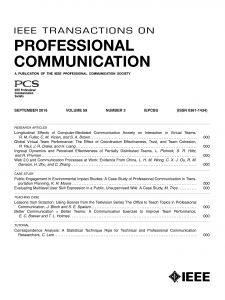3Q16 Issue of IEEE Transactions on Professional Communication
Published on September 11, 2016
 The September 2016 issue of the IEEE Transactions on Professional Communication has recently been published online. If you are a paper subscriber, you will receive the issue, printed together with the December issue, late this year. Click the link below to read about the articles included in this issue:
The September 2016 issue of the IEEE Transactions on Professional Communication has recently been published online. If you are a paper subscriber, you will receive the issue, printed together with the December issue, late this year. Click the link below to read about the articles included in this issue:
Volume 59, Number 3, September 2016
Research Article— Longitudinal Effects of Computer-Mediated Communication Anxiety on Interaction in Virtual Teams, by R. M. Fuller, C. M. Vician, and S. A. Brown
Organizations rely upon virtual teams, yet the effects of members’ computer-mediated communication (CMC) anxiety are not well-known. The results of this study indicate that individuals with higher levels of CMC anxiety participated less, sent fewer task-oriented messages, introduced fewer novel topics, and were rated more poorly by team members on performance. Additionally, participation quality and quantity and performance by CMC-anxious team members do not significantly improve, even with repeated interactions over CMC.
Research Article—Global Virtual Team Performance: The Effect of Coordination Effectiveness, Trust and Team Cohesion, by R. Paul, J. R. Drake, and H. Liang
This study evaluated how the process of effective coordination for teams composed of two co-located subgroups is mediated by individual perceptions of out-group trust and overall team cohesion. Findings show that individual trust and team cohesion share a reciprocal impact on each other, suggesting that effective coordination in virtual teams can create a positive feedback loop with trust and cohesion, improving overall project performance.
Research Article—Ingroup Dynamics and Perceived Effectiveness of Partially Distributed Teams, by L. Plotnick, S. R. Hiltz, and R. Privman
Partially distributed teams (PDTs) consist of at least two distinct geographically dispersed subgroups that communicate mainly through information and communication technology (ICT). It is important to understand how to manage them to maximize team effectiveness. An online survey of professionals with PDT experience found that ingroup dynamics have a strong negative relationship with perceived effectiveness. Overall, technology reliability and training significantly reduce ingroup dynamics, and training may not always be beneficial.
Research Article—Web 2.0 and Communication Processes at Work: Evidence from China, by L. H. M. Wong, C. X. J. Ou, R. M. Davison, H. Zhu, and C. Zhang
This study investigated the relationship between Web 2.0 use, and work-based communication processes and outcomes in China. It found that vertical and horizontal communication contribute significantly to individual and teamwork performance, with high levels of variance explained. The study also provides empirical evidence of how Web 2.0 applications enable employees to reach out to collaborators and business partners, thereby boosting individual productivity and team collaboration.
Case Study—Public Engagement in Environmental Impact Studies: A Case Study of Professional Communication in Transportation Planning, by K. R. Moore
This case reviews one public engagement project in transportation planning as implemented by one professional communications firm. It provides an overview of the process of developing public engagement plans, the deliverables designed, and the key goals that guided the development of public engagement. It suggests that effective public engagement can address intercultural concerns by developing projects that are adaptable, multimodal, and dialogic.
Case Study—Evaluating Multi-level User Skill Expression in a Public, Unsupervised Wiki: A Case Study, by M. Trice
This case study examines how users of varied experience levels interact with an open access content management system that lacks managed leadership. It found that users who maintained sufficient interest in the system to become experienced users developed a number of core skills even without organizational support, though new users demonstrated a steep skill deficit. However, new users actually demonstrated a greater capacity to recognize incompleteness of information than experienced users in one key task.
Teaching Case—Lessons from Scranton: Using Scenes from the Television Show The Office to Teach Topics in Professional Communication, by J. Bloch and S. E. Spataro
Despite efforts to include communication instruction, workplace surveys continually report that employees’ communication skills are lacking. The differing contexts of school and the workplace may be one reason for this disconnect, so teaching strategies that effectively bridge this gap are needed. After completing the class sessions and associated exercises described here, most students could discern the relevant concepts from the clips, found both the clips and the exercises helpful in learning the concepts, and recommended ongoing use in future classes.
Teaching Case—Better Communication = Better Teams: A Communication Exercise to Improve Team Performance, by E. C. Brewer and T. L. Holmes
This case seeks to answer two questions regarding miscommunication within teams: (1) Can a communication exercise create awareness among team members of the danger of miscommunication? (2) What benefits do team members gain from the exercise? The article describes a classroom exercise that relies on an integrative model for improving communication within teams. It also presents evidence of the exercise’s effectiveness in raising awareness and fostering accommodation and social learning among team members.
Tutorial—Correspondence Analysis: A Statistical Technique Ripe for Technical and Professional Communication Researchers, by C. Lam
Correspondence analysis is a statistical method that allows researchers to explore relationships among complex categorical variables. This article provides researchers with the theoretical and practical foundations for understanding and applying correspondence analysis to their own research agendas.
Book Review—R. Willerton, Plain Language and Ethical Action: A Dialogic Approach to Technical Content in the Twenty-First Century, reviewed by K. Dreher
The issue is available online at: http://ieeexplore.ieee.org/xpl/RecentIssue.jsp?punumber=47. Note that a user ID and password are required to view individual articles.

